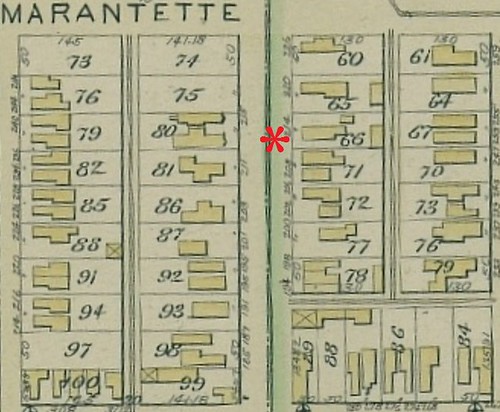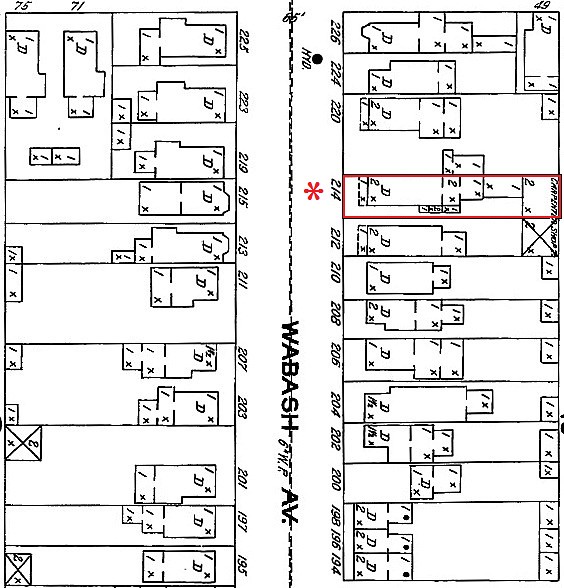
This two-family home, located at 2253-2255 (formerly 305-307) Wabash, was built on a lot that was once part of the Cicotte / Godfroy Farm. The history of that farm has been covered in a previous post, so there is no need to repeat it here. The segment of the farm south of Michigan Avenue was divided into individual lots in 1864. On April 26 of that year, lot number 26 was purchased by a forty-four-year-old real estate dealer named Ralph Phelps.
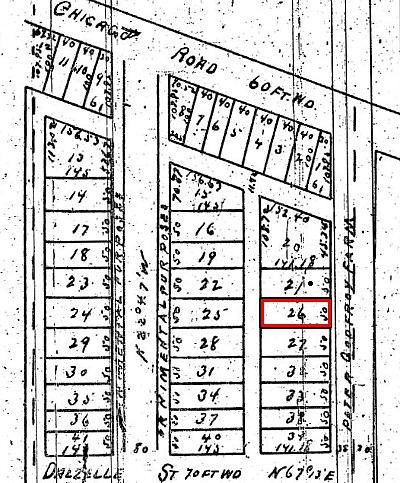
Plat of the Godfroy Farm south of Chicago Road (State of Michigan)
Two years later, Ralph Phelps sold lot 26 to Horace Fosdick.
Horace Forsdick
Horace P. Forsdick was born January 23, 1833 in Suffolk County, England to Benjamin and May Ann (Easter) Forsdick. He came to Detroit around 1860. On April 26 of that year, he appeared in Recorder's Court to declare his intention to become a United States citizen.

At the outbreak of the Civil War, Forsdick enlisted with Company C of the 1st Regiment of US Sharpshooters on August 26, 1861. Applicants were required to pass a strict marksmanship test in order to be accepted. Having been mustered into the Army of the Potomac, Company C fought in a number of major battles, including Antietam, Fredericksburg, and Gettysburg.

This monument at Gettysburg honors the 1st Regiment of U.S.
Sharp shooters from Michigan. A plaque on the front states that
Company C fought on that field July 2 & 3, 1863. (Stone Sentinels)
Several weeks after the Battle of Gettysburg, on September 30, 1863, Forsdick was transferred to the Veteran Reserve Corps, which engaged in either light- or non-military duties. The Second Battalion, to which Forsdick was transferred, was reserved for soldiers who sustained severe injuries or disease. The exact cause of the transfer will not be known until his consolidated service record and pension files are obtained from the National Archives. Forsdick's company in the Veteran Reserve Corps, No. 30, was mustered out by detachments between August and November of 1865.
When Forsdick returned to Detroit, he worked as a painter for the Michigan Central Rail Road. On December 19, 1865 he married Cornelia Sutherland in Scotch Presbyterian Church, which once stood on the corner of Farmer and Bates Streets. Cornelia was the daughter of James and Helen Bine Sutherland, both Scottish immigrants. Mr. Sutherland worked as an undertaker on the east side of the city.
On May 8, 1866, Forsdick purchased the previously mentioned "lot 26" for $350. He is listed as living at that location in the 1866 city directory. Building permits were not required at the time, so there is no way to know the exact date of the construction of that first home (not the same as the duplex that stands there today). It's possible there was already a house on the lot when Forsdick purchased it, but $350 would be extremely cheap even for a modest house in 1866.
Horace and Cornelia raised several children in this first house, which was addressed as 305 Wabash. Around 1886, Forsdick moved out of the home but retained it as a rental property.
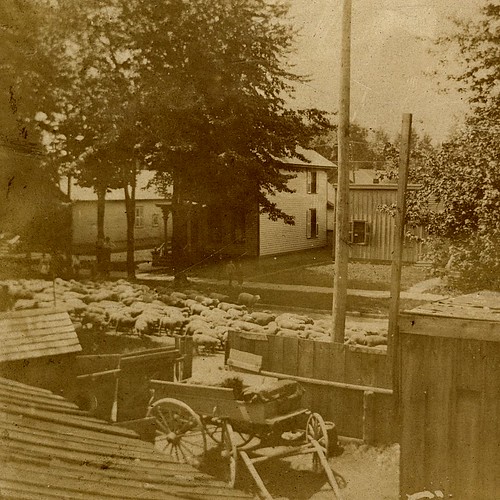
A note on the back of this photo states that it was taken on Wabash near
Michigan Avenue in 1901. "Sheep on Wabash Ave." is written on the front.
Courtesy of the Burton Historical Collection, Detroit Public Library.
The one-story home on the far left of the above photograph is Fordick's former home at 305 Wabash. Using the 1897 Sanborn map of Detroit, it is possible to locate where the photographer was located and identify which buildings appear in the image.

Sheep Photoshopping by Anny Bouchard
The house just south of Forsdick's property (not in the photo) is the beautifully restored Joseph Esterling House at 2245 (formerly 301) Wabash Street.
Construction
On January 2, 1900, Horace Forsdick quit-claimed the property to his thirty-one-year-old daughter, Elizabeth C. Forsdick. In 1902, Horace Forsdick hired a contractor named Hugh Finlay to build a three-unit townhouse on Toledo Street between Cavalry and Campbell (since demolished), in which Forsdick was to spend the rest of his life. His daughter was evidently so satisfied with Finlay's work that she decided to demolish 305 Wabash and hire Finlay to build a two-family home in its place. The City of Detroit issued Finlay the building permit on June 26, 1903. The application describes the intended building as a wood-frame, brick-veneer structure measuring 40 by 52 feet. The estimated cost to build it was $5,200.
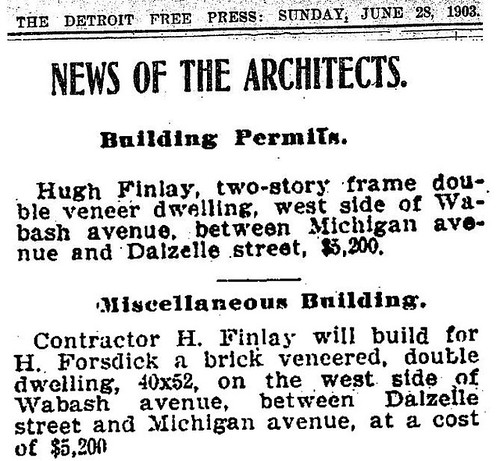
Two separate notices of the building permit appeared
on the same newspaper page, perhaps by accident.
The builder, Hugh Coulter Finlay, was born in Ontario on May 7, 1853 to Irish immigrants James and Mary Ann (Coulter) Finlay. Hugh Finlay came to the United States in 1881 and married Jane Emily Soules October 1, 1854 in Chicago. They had two children by the time they came to Detroit, but only one of them lived to adulthood. Finlay died in San Bernardino, California on August 11, 1942 and his cremated remains were interred in the family plot at Woodmere Cemetery in Detroit.
Horace Forsdick died on March 30, 1919 and was interred at Elmwood Cemetery, Section P, Lot 6, Grave 13. Despite having fought for the Union in the Civil War, there is no marker on his grave. Elizabeth Forsdick would own the two-family home on Wabash Street until her death in 1953. However she never lived in the home--in fact, it doesn't appear to have ever been owner-occupied.
Because this research was requested by the current occupant of the north half of the duplex, this post will focus on the previous occupants of that unit.
The Harker Family
The first people to live in the north half of the new duplex were Joshua and Catherine Harker. Joshua Harker was born to Joseph and Margaret (Teasdale) Harker on February 13, 1845 in Guisborough, England. His family immigrated to Delaware Township, Ontario, Canada in the 1850s, and he had moved to Lyon Township, Michigan in the late 1860s. On November 9, 1869, Harker married Catherine Rosella Arms, born July 2, 1846 in Brighton, Michigan to Israel and Julia Ann (Parsons) Arms, pioneers who came to Michigan from New England in the 1820s. Joshua and Catherine Harker had three children: Ward Wesson, Clarence Parsons (who died at eight months), and Edith Mille. An 1875 gazetteer lists Joshua Harker as a blacksmith.
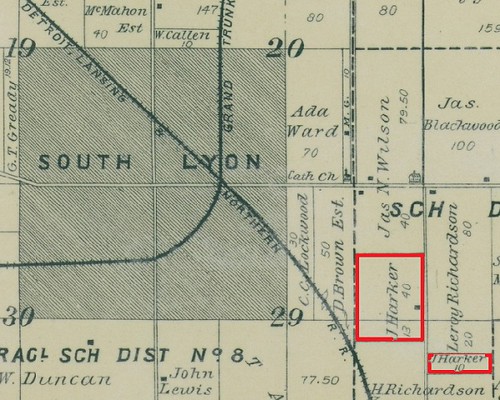
Joshua Harker's farm in Lyon Township (Bentley Historical Library)
In 1895, Joshua and Catherine Harker moved to Detroit, where their children had already settled. Harker started a moving company and a wood and coal wholesale business soon after moving to the city.
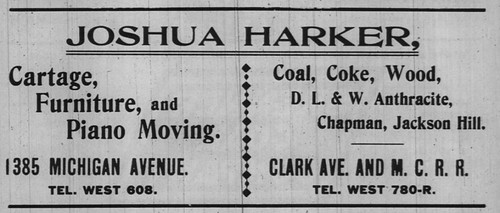
Advertisement from a 1904 Detroit city directory (footnote.com)
The Harkers lived at several addresses in southwest Detroit before finally settling at 307 Wabash Avenue in 1904. Their daughter Edith, who graduated from the University of Michigan's training school for nurses the previous year, moved in with them at this address.

October 14, 1906 ad from the Detroit Free Press.
The family had only lived in the home for three years before Joshua Harker passed away. He died at home on June 6, 1907 from paresis caused by "nervous worry over business and rheumatism".

Death certificate for Joshua Harker (Seeking Michigan)
Catherine Harker and her daughter Edith had moved to another home by 1908.
The Waite Family
The next family listed at 307 Wabash was that of Jackson C. and Mary E. Waite. All that is known about Jackson C. Waite is that he was born in the state of New York in June 1861. Mary E. Waite was born in Bath, New York in March 1861 to Thomas and Rachel (Moore) Stenson, both Irish immigrants. Jackson and Mary Waite married around 1881, moved to Jackson, Michigan before 1884, and settled in Detroit by 1887. Mr. Wait's listed occupation was "traveling agent", which was the term then used for traveling salesmen and similar kinds of company representatives. When the family moved into the Finlay Duplex in 1908, their three adult sons lived with them:
- Henry Fowler Waite - Born April 3, 1882 in State of New York. Employed as a clerk by the Burroughs Adding Machine Company.
- Robert Lawrence Waite - Born October 11, 1884 in Jackson, Michigan. He briefly co-owned a pool hall on Michigan Avenue past 17th Street with William J. Brennan, and was later listed as a driver.
- Edward Lawrence Waite - Born September 4, 1888 in Detroit. Worked as a clerk for dry goods wholesaler Edson, Moore & Co.

Detail from 1910 Census listing residents of 307 Wabash Street.
Around 1916, Jackson C. Waite disappeared. His wife and sons remained in the home for years afterward, but there was no record of his death or of him living anywhere near the area. It was as if he vanished. ... Or did he? (Hint: Check back for a future blog post about Mr. Waite.)

Detail from the 1920 Census listing residents of 307 Wabash Street.
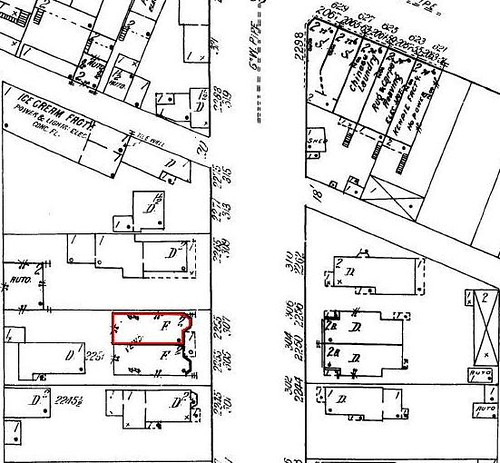
The Waite household and vicinity in 1921. This was the year
that the address changed from 307 to 2255. (Sanborn)
Harry Waite was later employed as a warehouse superintendent at People's Outfitting Company. The building the company used at the time was torn down several years ago to be replaced with a parking garage.

Detail from 1930 Census listing residents of 2255 Wabash Street.
Robert Waite died in Essex County, Ontario on July 25, 1930. The last year the Waites were known to live at this address was 1941. Mary E. (Stenson) Waite died in Detroit on September 23, 1946.
1941-Present
No city directories were published during World War II, and the Detroit Public Library's collection of directories is sporadic after that point. Ironically, it's easier to find out who lived in a historic home 100 years ago than it is to list those who lived there within the last fifty years.
After the death of Elizabeth Forsdick, the administrator of her estate, Robert G. Shaw, sold the duplex to Leo and Irene Eagle on March 25, 1954 for $9,000. Mr. and Mrs. Eagle sold it just three months later, on June 10, 1954, to James D. and Ella Aristos.
The 1956 city directory indicates that 2255 Wabash was rented by Alice Schuler and her sons Chester and Howard. Alice M. (Ryan) Schuler was born in Canada in 1883 and married Peter C. Schuler in Rochester, New York in 1911. In addition to the two sons already mentioned, the Schulers also had two daughters, Thelma and Norma. Peter Schuler died before 1930, and the family moved to Detroit at an unknown date. Chester J. Schuler worked as a mail sorter for the railroad, and Howard P. Schuler was a driver for Checker Cab. The Schulers were still living in the home at the time of the 1964 city directory, but it's not known exactly how long they lived there.

2253-2255 Wabash as it appeared in 1976.
Courtesy of the Michigan State Historic Preservation Office.
The property changed hands several more times before the present day:
- April 17, 1975 -- From James D. and Ella Aristos to Joseph and Josephine Attard, for $12,000.
- November 15, 1982 -- Joseph and Josephine Attard to Mario A. and Debra L. Zavala, for $16,000.
- April 3, 1987 -- Mario A. and Debra L. Zavala to Brian W. Tremain, for $36,000. At the time, Tremain's residence was 2245 Wabash, the previously-mentioned Esterling House. Tremain now lives in Kentucky.
- September 20, 1996 -- Brian Tremain to Jeanne Fitzgerald.
- April 20, 2004 -- Jeanne Fitzgerald to Faith Fowler. Fowler is currently the executive director of Cass Community Social Services and Senior Pastor of Cass Community United Methodist Church.




